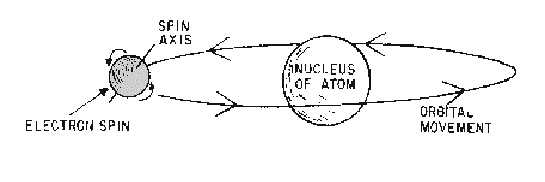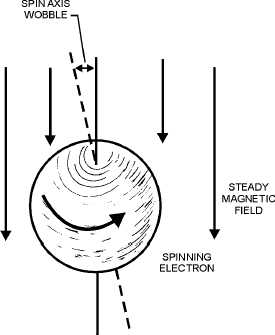1-59
Figure 1-73.—Two types of electron movement.
In the absence of an external force, the axis of any spinning object tends to remain pointed in one
direction. Spinning electrons behave the same way. Therefore, once the electrons are aligned, they tend to
remain aligned even when the external field is removed. Electron alignment in a ferrite is caused by the
orbital motion of the electrons about the nucleus and the force that holds the atom together. When a static
magnetic field is applied, the electrons try to align their spin axes with the new force. The attempt of the
electrons to balance between the interaction of the new force and the binding force causes the electrons to
wobble on their axes, as shown in figure 1-74. The wobble of the electrons has a natural resonant
WOBBLE FREQUENCY that varies with the strength of the applied field. Ferrite action is based on this
behavior of the electrons under the influence of an external field and the resulting wobble frequency.
Figure 1-74.—Electron wobble in a magnetic field.
FERRITE ATTENUATORS.—A ferrite attenuator can be constructed that will attenuate a
particular microwave frequency and allow all others to pass unaffected. This can be done by placing a
ferrite in the center of a waveguide, as shown in figure 1-72. The ferrite must be positioned so that the
magnetic fields caused by its electrons are perpendicular to the energy in the waveguide. A steady
external field causes the electrons to wobble at the same frequency as the energy that is to be attenuated.



